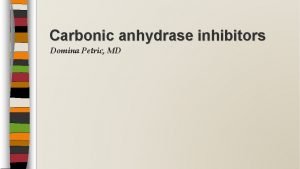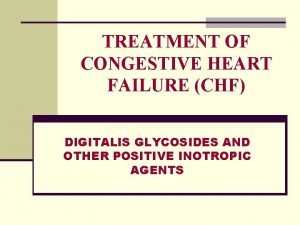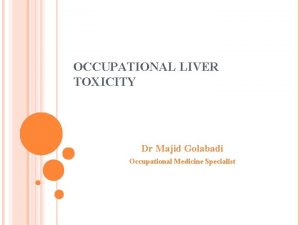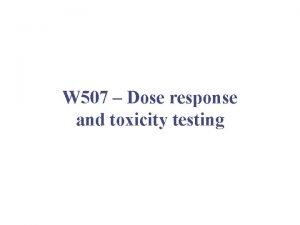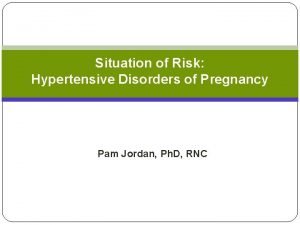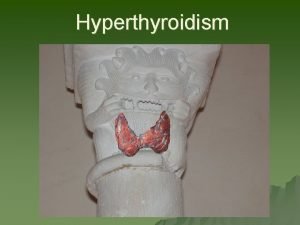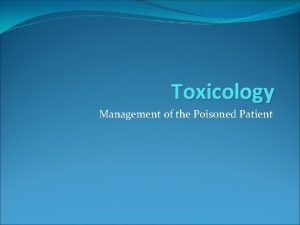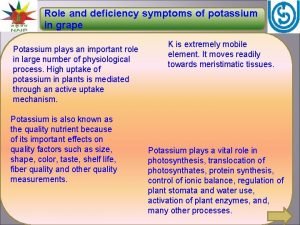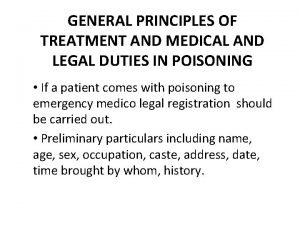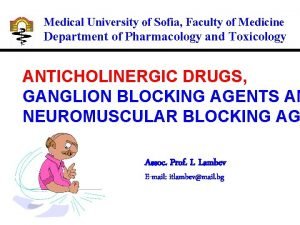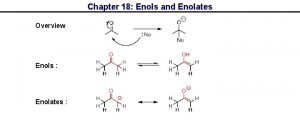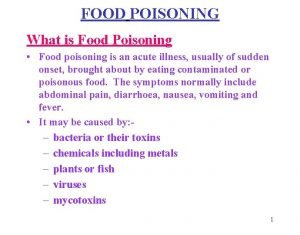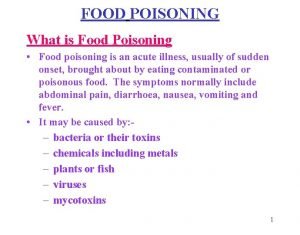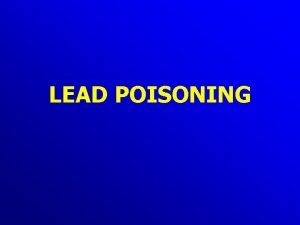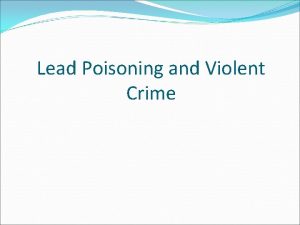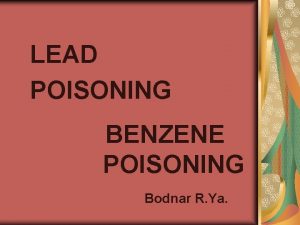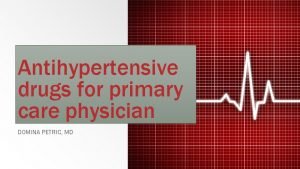Lead toxicity Domina Petric MD Lead Lead poisoning































































- Slides: 63

Lead toxicity Domina Petric, MD

Lead • Lead poisoning is one of the oldest occupational and environmental diseases in the world. Lead has widespread commercial application: • production of storage batteries • ammunition • metal alloys • solder • glass • plastics • pigments • ceramics

Lead may have subtle subclinical adverse effects on neurocognitive function and on blood pressure even at low blood lead concentrations.

Pharmacokinetics Inorganic lead is slowly, but consistently absorbed via the respiratory and gastrointestinal tract. Inorganic lead is poorly absorbed through the skin.

Pharmacokinetics • Absorption of lead dust via the respiratory tract is the most common cause of industrial poisoning. • The intestinal tract is the primary route of entry in nonindustrial exposure.

Pharmacokinetics • Adults absorb about 10 -15% of the ingested amount. • Young children absorb up to 50%. • Low dietary calcium, iron deficiency and ingestion on an empty stomach are associated with increased lead absorption.

Pharmacokinetics After absorption lead enters the bloodstream: • 90% is bound to erythrocytes • 1% is present in the plasma

Lead distribution Bone matrix Soft tissues: bone marrow, brain, kidney, liver, muscle, gonads Subperiosteal surface of bone

Pharmacokinetics • Lead crosses the placenta and poses a potential hazard to the fetus. The kinetics of lead clearance: • half-life for blood and soft tissues is 1 -2 months • half-life for skeleton is years to decades

Pharmacokinetics • 70% of eliminated lead is in the urine. • Lesser amounts are excreted through the bile, skin, hair, nails, sweat and breast milk. • The fraction not undergoing prompt excretion (up to 50%) may be incorporated into the skeleton.

Pharmacokinetics In patients with high bone lead burdens, slow release from the skeleton may elevate blood lead concentrations for years after exposure ceases.

Pharmacokinetics Pathologic high bone turnover states (hyperthyroidism, prolonged immobilization) may result in frank lead intoxication.

Pharmacokinetics Migration of retained lead bullet fragments into a joint space or adjecent bone may cause lead poisoning sings and symptoms years or decades after an initial gunshot injury.

PHARMACODYNAMICS

Multisystemic toxic effects of the lead are based on several mechanisms: • • • inhibition of enzymatic function interference with the action of essential cations (calcium, iron, zinc) generation of oxidative stress changes in gene expression alterations in cell signaling disruption of the integrity of cell´s and organelles membranes

Nervous system The developing central nervous system of the fetus and young child is the most sensitive target organ for lead´s toxic effect. Blood lead concentrations even less than 5 mcg/d. L may result in subclinical deficits in neurocognitive function in leadexposed young children.

Nervous system Adults are less sensitive to the central nervous system effects of lead. Long term exposure to blood lead concentrations in the range of 10 -30 mcg/d. L may be associated with subtle, subclinical effects on neurocognitive function.

Signs and symptoms at blood lead levels >30 mcg/d. L • • • irritability fatigue decreased libido anorexia sleep disturbances slowed reaction time • impaired visualmotor coordination • headaches • arthralgias • myalgias • tremor

Lead encephalopathy Usually occurs at blood lead concentrations >100 mcg/d. L. It is accompanied by increased intracranial pressure. It may cause ataxia, stupor, coma, convulsions and death.

Nervous system ! Lead may accentuate an age-related decline in cognitive function in older adults.

Peripheral neuropathy • It may appear after chronic high dose lead exposure. • Usually months to years of blood lead concentrations >100 mcg/d. L. • It is predominantly motor in character: painless weakness of the extensors, particularly in the upper extremity with classic wrist drop.

Gutemberg. org

Blood Lead can induce normocytic or microcytic hypochromic anemia. Lead interferes with heme synthesis by blocking the incorporation of iron into protoporphyrin IX. Lead also inhibits the function of enzymes in the heme synthesis pathway: aminolevulinic acid dehydratase, ferrochelatase.

Blood • Lead can also increase erythrocyte membrane fragility and decrease red cell survival time. • Frank hemolysis may occur with high exposure. • Basophilic stippling on the peripheral blood smear!

Basophilic stippling Image source: Pinterest. com

Kidneys • Chronic high-dose lead exposure (>80 mcg/d. L) for months to years may result in renal interstitial fibrosis and nephrosclerosis. • Lead nephropathy may have a latency period of years.

Kidneys Lead may alter uric acid excretion by the kidney resulting in recurrent bouts of gouty arthritis called saturnine gout. Health. wikinut. com

Kidneys • Acute high dose lead exposure sometimes produces transient azotemia caused by intrarenal vasoconstriction. • There is association between blood lead concentrations and serum creatinine (and creatinine clearance).

Kidneys The presence of hypertension and diabetes may increase susceptibility to lead -induced renal dysfunction.

Reproductive organs • High dose lead exposure is a risk factor for stillbirth or spontaneous abortion. • Even low level lead exposure can increase risk for low birht weight, preterm delivery and spontaneous abortion.

Reproductive organs Prenatal exposure to low levels of lead (maternal blood lead 5 -15 mcg/d. L) is associated with decrements in physical and cognitive development. In males, blood lead conc. >40 mcg/d. L are associated with diminished or aberrant sperm production.

Gastrointestinal tract Moderate lead poisoning may cause: • loss of apetite • constipation • diarrhea

Gastrointestinal tract At high dosage, intermittent bouts of severe colicky abdominal pain (lead colic) may occur. Lead colics may be due to spasmodic contraction of the smooth muscles of the intestinal wall, mediated by alteration in synaptic transmission at the smooth muscle-neuromuscular junction.

Gastrointestinal tract • In heavily exposed individuals with poor dental hygiene, the reaction of circulating lead with sulfur ions released by microbial action, may produce DARK DEPOSITS OF LEAD SULFIDE at the gingival margin: GINGIVAL LEAD LINES.

portal. dentistry. vcu. edu

Cardiovascular system Lead exposure elevates blood pressure in susceptible individuals. Blood lead concentration is linked with increases in systolic and diastolic blood pressure.

Cardiovascular system • Low to moderate levels of lead exposure are risk factors for increased cardiovascular mortality. • The pressor effect of lead may be mediated by an interaction with calcium mediated concentration of vascular smooth muscle, generation of oxidative stress and an associated interference in nitric oxide signaling pathways.

Inorganic lead poisoning: acute and chronic Organolead poisoning MAJOR FORMS OF LEAD INTOXICATION

Acute inorganic lead poisoning • Uncommon today. • It can happen as industrial inhalation of large quantities of lead oxide fumes in workers. • In children, from ingestion of a large oral dose of lead (toys coated or fabricated from lead, contaminated food or drink).

Acute inorganic lead poisoning • The onset of severe symptoms occurs several days or weeks of recurrent exposure: encephalopathy and colic symptoms. • There may be evidence of hemolytic anemia and elevated hepatic aminotransferases.

Acute inorganic lead poisoning • Acute inorganic lead poisoning may be mistaken for appendicitis, peptic ulcer, biliary colic, pancreatitis or infectious meningitis. • Subacute presentation may be mistaken for a flu-like viral illness: headache, fatigue, intermittent abdominal cramps, myalgias and arthralgias.

Chronic inorganic lead poisoning • • anorexia fatigue malaise weakness arthralgias myalgias gastrointestinal symptoms Neurologic complaints: • headache • difficulty in concentrating • irritability • depressed mood

Chronic inorganic lead poisoning Lead poisoning should be suspected in patient presenting with: ABDOMINAL PAIN • HEADACHE • ANEMIA •

Chronic inorganic lead poisoning Less commonly, but very important for diagnosis of lead poisoning are: • MOTOR NEUROPATHY • GOUT • RENAL INSUFFICIENCY

Chronic inorganic lead poisoning This diagnosis should be considered in any child with: • NEUROCOGNITIVE DEFICITS • GROWTH RETARDATION • DEVELOPMENTAL DELAY

Chronic inorganic lead poisoning • Measuring lead in whole blood is not a reliable marker of recent or cumulative lead exposure, but it is usefull diagnostic tool. • Most patients with lead-related disease have blood lead concentrations higher than the normal range.

Chronic inorganic lead poisoning The concentration of lead in bone assessed by noninvasive K X-ray flourescence measurement of lead has been correlated with long term cumulative lead exposure.

Chronic inorganic lead poisoning • Measurement of lead excretion in the urine after a single dose of a chelating agent (chelation challenge test) reflects the lead content of soft tissues. • It is not a reliable marker of long term lead exposure, remote past exposure or skeletal lead burden.

Chronic inorganic lead poisoning • The finding of a blood lead concentration of 30 mcg/d. L or more with no concurrent increase in zinc protoporphyrin suggests that the lead exposure was of recent onset.

Treatment Immediate termination of exposure! Supportive care! Chelation therapy!

Treatment • Lead encephalopathy is a medical emergency that requires intensive supportive care. • Cerebral oedema may be improved with corticosteroids and mannitol. • Anticonvulsants are required for the treatment of convulsions.

Treatment Radiopacities on abdominal radiographs may suggest the presence of retained lead objects. Gastrointestinal decontamination is necessary in this case. Adequate urine flow should be maintained. Overhydration should be avoided.

Treatment Intravenous edetate calcium disodium (Ca. Na 2 EDTA) 1000 -1500 mg/m 2/d in continous infusion for up to 5 days.

Treatment Some clinicians use dimercaprol intramuscular injection in case of lead encephalopathy, followed in 4 hours by concurrent administration EDTA.

Treatment • Parenteral chelation is limited to 5 or fewer days, at which time oral treatment may be instituted. • Succimer is peroral chelator. • In lead intoxication without encephalopathy, treatment may be initiated with succimer.

Treatment • Goal of chelation is resolution of symptoms or return of the blood lead concentration to the premorbid range. • In chronic lead poisoning, cessation of chelation may be followed by an upward rebound in blood lead concentration as the lead reequilibrates from bone lead stores.

Treatment CDC has recommended chelation for all children with blood lead concentrations of 45 mcg/d. L or greater.

Prevention Prophylactic use of chelating agents in the workplace should never be a substitute for reduction or prevention of excessive exposure.

Prevention • The longer-term goal should be for workers to maintain blood lead levels at lower than 10 mcg/d. L. • For pregnant women goal is to avoid occupational or avocational exposure that would result in blood lead levels higher than 5 mcg/d. L.

Organolead poisoning • Today very rare. • Organolead compounds like lead stearate and lead naphthenate are still used in some commercial processes. • Organolead compounds are well absorbed through the respiratory tract and skin.

Organolead poisoning Organolead compounds target the central nervous system and produce dose-dependent effects: • neurocognitive deficits • insomnia, delirium, hallucinations • tremor, convulsions • death

Treatment Decontamination of the skin and prevention of further exposure! Treatment of seizures with anticonvulsants. Empiric chelation if high blood lead concentrations are present.

Literature • Katzung, Masters, Trevor. Basic and clinical pharmacology. • Gutemberg. org • Pinterest. com • Health. wikinut. com • Portal. dentistry. vcu. edu
 Quasi vitamins
Quasi vitamins Md
Md Domina petric
Domina petric Pseudomonopolar
Pseudomonopolar Rexocef 100
Rexocef 100 Domina tasks
Domina tasks Domina petric
Domina petric Pica jopo sting
Pica jopo sting Nero lead poisoning
Nero lead poisoning Lead poisoning children
Lead poisoning children Common factors that can lead to food poisoning
Common factors that can lead to food poisoning Infectious mononucleosis
Infectious mononucleosis Jure petric
Jure petric Ljubavno predvečerje
Ljubavno predvečerje 8 atitudes vencedoras
8 atitudes vencedoras Domina los aprendizajes requeridos
Domina los aprendizajes requeridos Casi indiretti
Casi indiretti Cada miembro domina una parcela determinada del proyecto
Cada miembro domina una parcela determinada del proyecto Domina severe
Domina severe Kitzler witze
Kitzler witze Mountains into molehills mass-mole conversions answer key
Mountains into molehills mass-mole conversions answer key Cardiac toxicity treatment
Cardiac toxicity treatment Hepatic toxicity
Hepatic toxicity Ghs pictogram depicts which hazard
Ghs pictogram depicts which hazard Definition of chronic toxicity
Definition of chronic toxicity W 507
W 507 Toxicity index
Toxicity index Anticholinergic toxicity mnemonic
Anticholinergic toxicity mnemonic Poxymeter
Poxymeter Acute toxicity
Acute toxicity Role vitamin a
Role vitamin a Definition of chronic toxicity
Definition of chronic toxicity Vitamin d toxicity
Vitamin d toxicity Vitamin b complex action
Vitamin b complex action Acute toxicity
Acute toxicity Alcohol toxicity
Alcohol toxicity What is oxygen toxicity
What is oxygen toxicity Lithium toxicity
Lithium toxicity B6 toxicity symptoms
B6 toxicity symptoms Digoxin toxicity mnemonic
Digoxin toxicity mnemonic Treatment of salicylate toxicity
Treatment of salicylate toxicity Digoxin mechanism of action
Digoxin mechanism of action Magnesium sulfate toxicity level
Magnesium sulfate toxicity level Rais calculator
Rais calculator History of vitamin c
History of vitamin c Organophosphate toxicity
Organophosphate toxicity Tachicardis
Tachicardis Mcgreafor
Mcgreafor Risk assessment apes
Risk assessment apes Zinc toxicity
Zinc toxicity Lithium toxicity
Lithium toxicity Apap
Apap Symptoms of potassium
Symptoms of potassium Rip, ospf, bgp
Rip, ospf, bgp Mercury poisoning symptoms
Mercury poisoning symptoms General principle of treatment of poisoning
General principle of treatment of poisoning Dns vulnerabilities
Dns vulnerabilities Curare poisoning
Curare poisoning Food poisoning cause
Food poisoning cause Dose of atropine in op poisoning
Dose of atropine in op poisoning Dose of atropine in op poisoning
Dose of atropine in op poisoning Dioxin poisoning
Dioxin poisoning Diya kaduru
Diya kaduru Gamaxin powder poisoning
Gamaxin powder poisoning


















